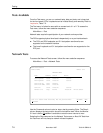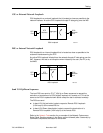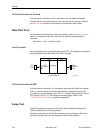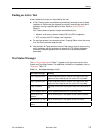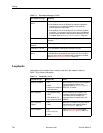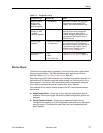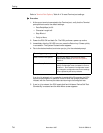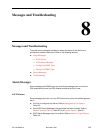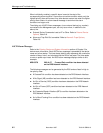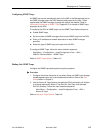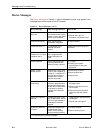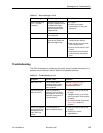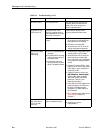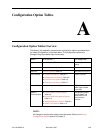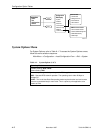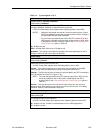
Messages and Troubleshooting
8-2
7610-A2-GB20-10
November 1997
When individually enabled, a specific alarm is sent at the start of the
corresponding alarm condition. If more than one alarm condition exists, only the
highest priority alarm will be sent. Any other alarms are sent out when the higher
priority alarm clears. An alarm cleared message is sent when the alarm
conditions no longer exist.
The dialing out of ASCII Alarm messages, via an external device (e.g. modem)
connected to the Management port, can only occur when, in addition to the
above, the:
H External Device Commands is set to AT or Other. Refer to External Device
Options, Table A-6.
H Alarm and Trap Dial-Out is enabled. Refer to Alarms & Traps Options,
Table A-8.
ASCII Alarm Messages
Refer to the
Entering Device and System Information
section of Chapter 3 for
device name information. Each ASCII alarm message is preceded by the device
name and a time stamp. The time stamp
(ddd:hh:mm)
represents the cumulative
number of days, hours, and minutes since the DSU’s last reset. The time resets
to zero on power up or reset. An ASCII alarm message displays similar to this
example:
NE815378 283:14:57 Crossed Pair condition has been detected
on the DDS Network Interface
The following messages can be generated by the DSU and are listed in high to
low priority order:
H A Crossed Pair condition has been detected on the DDS Network Interface.
H A No Signal (NS) condition has been detected on the DDS Network Interface.
H An Out of Service (OOS) condition has been detected on the DDS Network
Interface.
H An Out of Frame (OOF) condition has been detected on the DDS Network
Interface.
H An Excessive Bipolar Violations (BPV) condition has been detected on the
DDS Network Interface.
H An In-Band Framing Error condition has been detected on the DDS Network
Interface.



